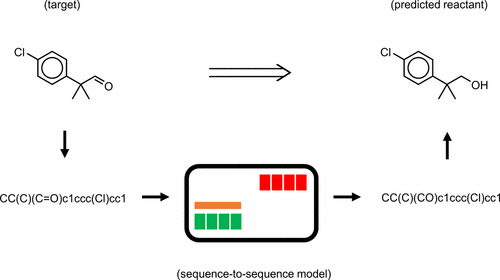当前位置:
X-MOL 学术
›
ACS Cent. Sci.
›
论文详情
Our official English website, www.x-mol.net, welcomes your
feedback! (Note: you will need to create a separate account there.)
Retrosynthetic Reaction Prediction Using Neural Sequence-to-Sequence Models.
ACS Central Science ( IF 12.7 ) Pub Date : 2017-09-05 , DOI: 10.1021/acscentsci.7b00303 Bowen Liu 1 , Bharath Ramsundar 2 , Prasad Kawthekar 2 , Jade Shi 1 , Joseph Gomes 1 , Quang Luu Nguyen 1 , Stephen Ho 1 , Jack Sloane 1 , Paul Wender 1, 3 , Vijay Pande 1, 2, 4
ACS Central Science ( IF 12.7 ) Pub Date : 2017-09-05 , DOI: 10.1021/acscentsci.7b00303 Bowen Liu 1 , Bharath Ramsundar 2 , Prasad Kawthekar 2 , Jade Shi 1 , Joseph Gomes 1 , Quang Luu Nguyen 1 , Stephen Ho 1 , Jack Sloane 1 , Paul Wender 1, 3 , Vijay Pande 1, 2, 4
Affiliation

|
We describe a fully data driven model that learns to perform a retrosynthetic reaction prediction task, which is treated as a sequence-to-sequence mapping problem. The end-to-end trained model has an encoder-decoder architecture that consists of two recurrent neural networks, which has previously shown great success in solving other sequence-to-sequence prediction tasks such as machine translation. The model is trained on 50,000 experimental reaction examples from the United States patent literature, which span 10 broad reaction types that are commonly used by medicinal chemists. We find that our model performs comparably with a rule-based expert system baseline model, and also overcomes certain limitations associated with rule-based expert systems and with any machine learning approach that contains a rule-based expert system component. Our model provides an important first step toward solving the challenging problem of computational retrosynthetic analysis.
中文翻译:

使用神经序列到序列模型的逆合成反应预测。
我们描述了一个完全数据驱动的模型,该模型学习执行逆合成反应预测任务,该任务被视为序列到序列映射问题。端到端训练模型具有由两个循环神经网络组成的编码器-解码器架构,该架构此前在解决机器翻译等其他序列到序列预测任务方面取得了巨大成功。该模型根据美国专利文献中的 50,000 个实验反应示例进行训练,涵盖药物化学家常用的 10 种广泛反应类型。我们发现我们的模型的性能与基于规则的专家系统基线模型相当,并且还克服了与基于规则的专家系统以及包含基于规则的专家系统组件的任何机器学习方法相关的某些限制。我们的模型为解决计算逆合成分析的挑战性问题迈出了重要的第一步。
更新日期:2017-09-05
中文翻译:

使用神经序列到序列模型的逆合成反应预测。
我们描述了一个完全数据驱动的模型,该模型学习执行逆合成反应预测任务,该任务被视为序列到序列映射问题。端到端训练模型具有由两个循环神经网络组成的编码器-解码器架构,该架构此前在解决机器翻译等其他序列到序列预测任务方面取得了巨大成功。该模型根据美国专利文献中的 50,000 个实验反应示例进行训练,涵盖药物化学家常用的 10 种广泛反应类型。我们发现我们的模型的性能与基于规则的专家系统基线模型相当,并且还克服了与基于规则的专家系统以及包含基于规则的专家系统组件的任何机器学习方法相关的某些限制。我们的模型为解决计算逆合成分析的挑战性问题迈出了重要的第一步。











































 京公网安备 11010802027423号
京公网安备 11010802027423号